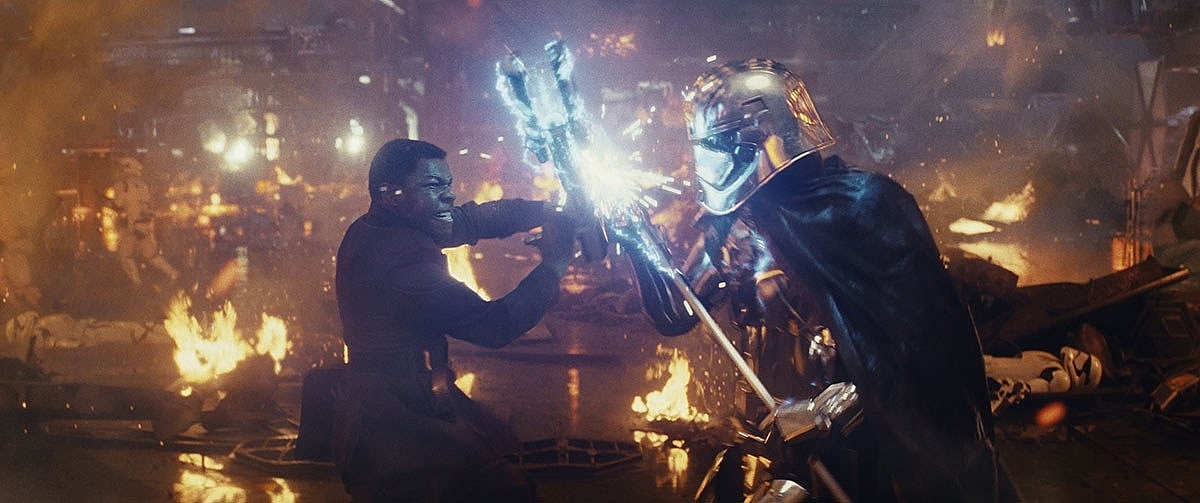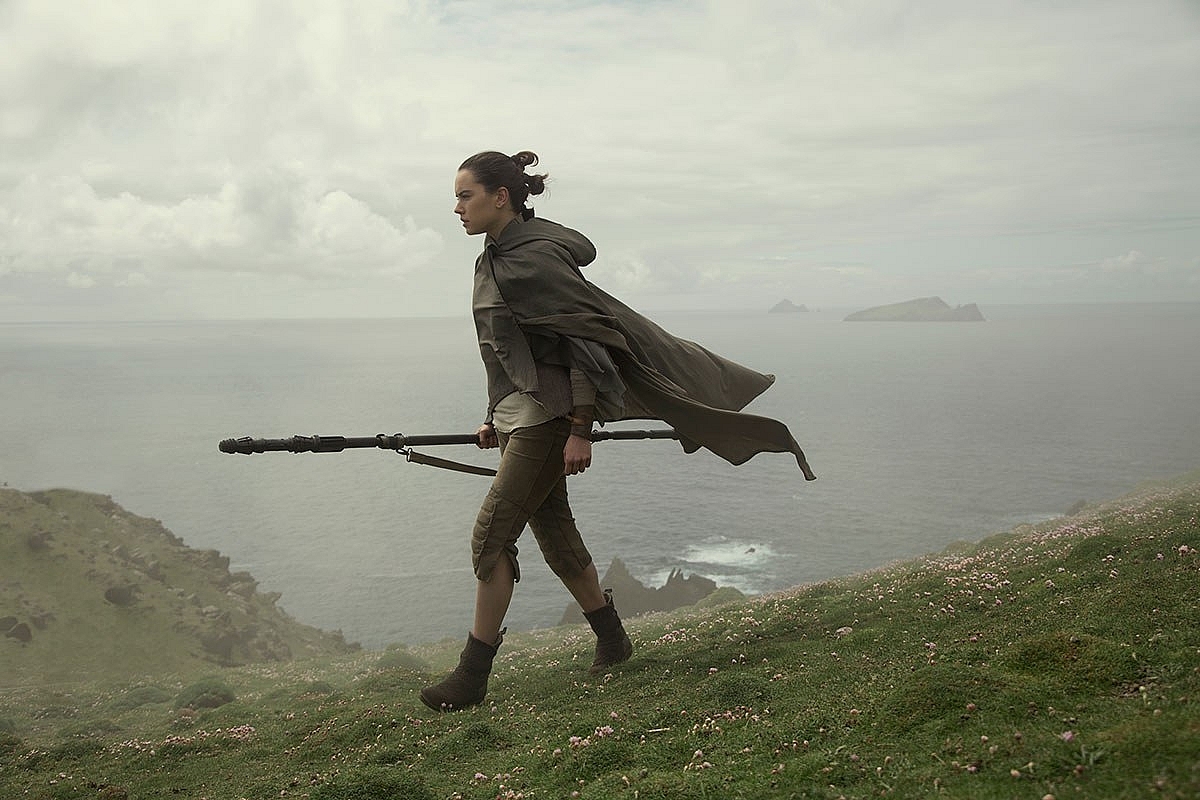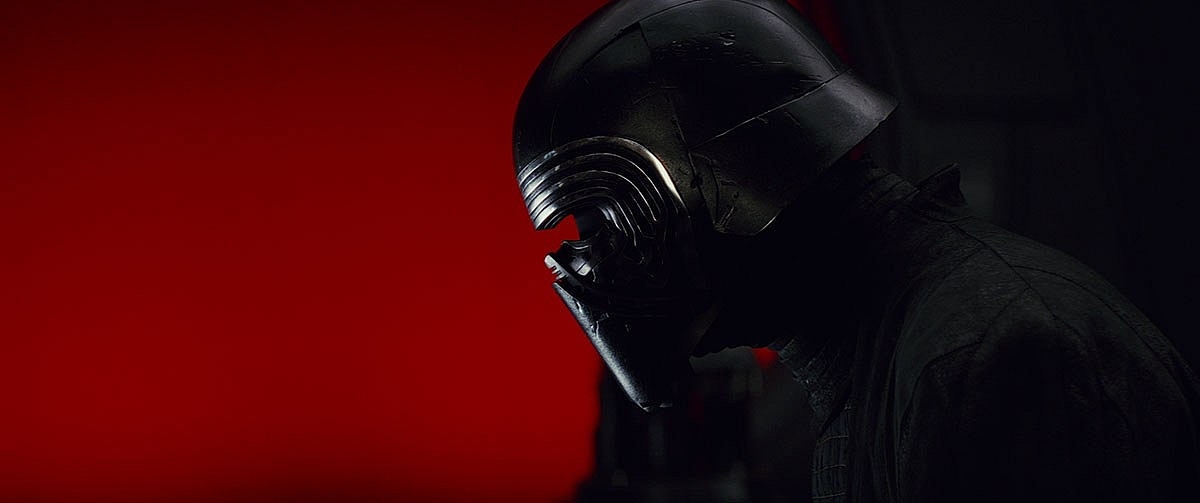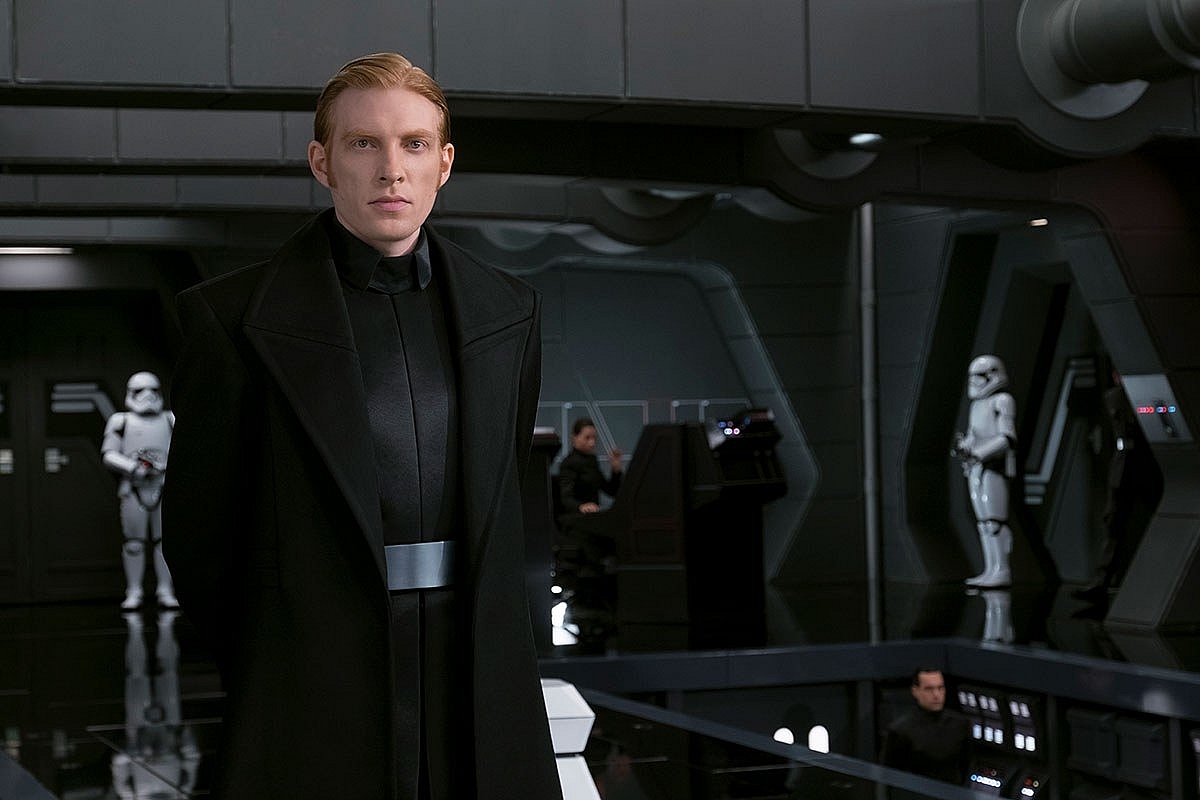The force is with film as 'Star Wars: The Last Jedi' tops $1.3 billion

"Star Wars: The Last Jedi." Rey (Daisy Ridley). Photo: Jules Heath. ©2017 Lucasfilm Ltd. All Rights Reserved.
Harnessing Kodak 35mm and Kodak 65mm film stocks, Star Wars: The Last Jedi had, at the time of writing, taken $1.3 billion worldwide with the total continuing to mount.
Already the highest-grossing film of 2017, this impressive figure made Star Wars: The Last Jedi the ninth-highest-grossing film of all time, as well as the second-highest-grossing film in the Star Wars franchise, following the $2 billion taken by JJ Abrams’ Star Wars: The Force Awakens (2015, DP Dan Mindel BSC ASC), which was shot on Kodak completely.

"Star Wars: The Last Jedi"… First Order hangar. Photo: Lucasfilm Ltd. © 2017 Lucasfilm Ltd. All Rights Reserved.
Directed by Rian Johnson with cinematography by Steve Yedlin ASC, the Lucasfilm/Walt Disney Pictures production sees Luke Skywalker's solitary existence shattered when he meets Rey, a young woman with strong signs of having The Force. Meanwhile, Kylo Ren and General Hux lead the First Order in a full-on bombardment against Leia and the Resistance for supremacy of the galaxy. Can Rey encourage the Jedi Master out of his seclusion to support the Resistance before it gets obliterated?

"Star Wars: The Last Jedi"… L to R: Rey (Daisy Ridley) and Luke Skywalker (Mark Hamill). Photo: Jonathan Olley. ©2017 Lucasfilm Ltd. All Rights Reserved.
Several exteriors of Skywalker’s island retreat, and associated action scenes, were filmed at Skellig Michael in Ireland during pre-production in September 2015. Principal photography began in earnest at Pinewood Studios, UK, in February 2016, where 125 sets were created across 14 sound stages, including the voluminous 007 Stage. The production also encompassed sets built at Longcross Studios in the UK. Further day, dusk and dusk-for-night Jedi Island exteriors were shot at many different headlands up and down the Western coast of Ireland for around two weeks during the main schedule, with full-night exteriors shot at Pinewood Studios and Longcross. Additional filming took place in Dubrovnik, Croatia, and location filming for the battle scenes on the planet Crait took place at the Salar de Uyuni salt flats in Bolivia. The production wrapped at the end of July 2016.

"Star Wars: The Last Jedi"… The planet Crait. Photo: Film Frames Industrial Light & Magic/Lucasfilm. ©2017 Lucasfilm Ltd. All Rights Reserved.
In a special Q&A interview for Kodak, Steve Yedlin ASC provides insight into his work on the record-breaking motion picture.
Q: How did you come to get involved with Star Wars: The Last Jedi?
A: Rian and I have been making films together since we were 18-years-old, starting out with little, homemade short films. Since then I’ve shot all of his features all on Kodak film: Brick (2005), The Brothers Bloom (2008), Looper (2012) and now The Last Jedi.

"Star Wars: The Last Jedi"… L-R: director Rian Johnson on-set with John Boyega (Finn) and Oscar Isaac (Poe Dameron). Photo: David James. ©2017 Lucasfilm Ltd. All Rights Reserved.
Q: What appealed to you about the production?
A: Star Wars was such an emotionally-charged and formative part of my childhood. It has always felt like pure magic. And there’s nothing I love more than working with Rian. This production was Star Wars and Rian in one, and I couldn’t imagine anything more exciting.

"Star Wars: The Last Jedi"… L-R: Finn (John Boyega) battling Captain Phasma (Gwendoline Christie). Photo: Lucasfilm Ltd. © 2017 Lucasfilm Ltd. All Rights Reserved.
Q: Did you consider any creative references before production began?
A: Rian and I have worked together for so long, that we’re sort of automatically on the same page with the high-level, abstract, inspirational/philosophical stuff that can be communicated with references.
So, we dispense with that type of communication pretty quickly at the very beginning and then spend the prep rolling-up the sleeves and getting down to the fine-grain details of designing and authoring each scene and shot.
Although references weren’t usually at the core of the communication between Rian and myself on this production, the reference we used to communicate with other collaborators most often was The Empire Strikes Back (1980), but even then, there was nothing literal we were trying to emulate from it – it was more of an inspiration.

"Star Wars: The Last Jedi"… L-R: Daisy Ridley (Rey) on the Skellig Island (Ach-to) set with director/writer Rian Johnson, and operator Gary Spratling BSC on-camera. Photo: Lucasfilm Ltd. ©2017 Lucasfilm Ltd. All Rights Reserved.
Q: When you first discussed the movie with Rian, how did you envisage the look of the film?
A: The first time I talked to Rian about how he wanted to approach the visuals, he said he didn’t want our choices to be determined by trying to emulate something from the original movies.
If we wanted to tell the best story possible through exciting visuals, we had to be free to author those visuals the best way we knew how – and to not second-guess ourselves, comparing our decisions to what we imagined someone else might have done in a different era with a different story. Also, Rian thought our personal filmmaking style and principles for visual storytelling were not so far removed from the classic Star Wars style, so it was not a big jolt.

"Star Wars: The Last Jedi"… Finn (John Boyega). Photo: Film Frames Industrial Light & Magic/Lucasfilm. ©2017 Lucasfilm Ltd. All Rights Reserved.
Q: How much time did you have for prep/pre-production?
A: I had about six months of continuous prep. But that was only after several months of non-continuous prep.

"Star Wars: The Last Jedi"… Admiral Ackbar behind the scenes on-set. "It's a wrap!". Photo: Lucasfilm Ltd. ©2017 Lucasfilm Ltd. All Rights Reserved.
Q: How long was the shoot? What was the working schedule?
A: About 100 days. It was surprisingly not tiring for such a long shoot. We were having so much fun, and Rian made every moment such a pleasure. Plus, we mostly did 10-hour continuous days, which not only made for fewer hours in a working week than many productions, but also meant we started at the same time almost every day. That allowed the body and mind to get onto a fixed schedule, which always feels better than the ever-drifting call time.

"Star Wars: The Last Jedi"… Rey (Daisy Ridley). Photo: Jules Heath. ©2017 Lucasfilm Ltd. All Rights Reserved.
Q: What did you shoot the movie on?
A: The movie was shot primarily with a mix of Kodak 35mm film and [digital cameras], but select scenes were photographed with [Kodak] IMAX 65mm 15-perf film and [large format digital].

"Star Wars: The Last Jedi"… Luke Skywalker (Mark Hamill). Photo: John Wilson. ©2017 Lucasfilm Ltd. All Rights Reserved.
Q: Which aspect ratio did you frame in and what were your lenses?
A: We shot in 2.39:1 aspect ratio, mainly using Panavision G-series Anamorphics, AWZ (40-80mm) and ATZ (70-200mm) zooms, along with a customized C-Series close focus 50mm and a 360mm that was converted to rear Anamorphic from a 180mm spherical lens. We often mixed spherical with the Anamorphic, and on these occasions, used the Panavision Primo 14.5mm, 17.5mm and 27mm, plus a PMZ 19-90mm. For the IMAX MSM camera, we used modified medium format lenses. Panavision London was the main provider, but we also got additional camera gear from ARRI Rental and from IMAX.

"Star Wars: The Last Jedi"… Kylo Ren (Adam Driver). Photo: Lucasfilm Ltd. © 2017 Lucasfilm Ltd. All Rights Reserved.
Q: Which film stocks did you use?
A: We used KODAK VISION3 5219 500T and KODAK VISION3 5207 250D, mostly 35mm 4-perf, with some KODAK 65mm 15-perf.
Q: What are the values of film that you particularly like?
A: I love the complexity and cinematic richness of the “look” that’s associated with traditional contact printing (i.e. camera negative directly contact-printed to print stock) – the long toe in the shadows and the long shoulder in the highlights, the complex skin tones and the color rendition that is so artful. But, there’s no out-of-the-box solution for scanned film to yield that contact-printed look. That’s partly why we did the rigorous color science in prep to make sure we could bring all stocks and cameras seamlessly into a single neutral space and, from there, create our show look inspired by traditional contact printing.

"Star Wars: The Last Jedi"… General Leia (Carrie Fisher). Photo: Lucasfilm Ltd. © 2017 Lucasfilm Ltd. All Rights Reserved.
Q: Which lab did you use?
A: Cinelab in London did the 35mm neg processing. Fotokem did the 65mm processing and scanning of both the 35mm and 65mm negative, as well as the creation of dailies and source files.
Q: What was your approach to the camera movement?
A: Rian and I love strong confident shots in which the compositions feel authored to tell the story rather than being accidental or messy. We always try to use a dolly or crane in preference to a Steadicam and reserve Steadicam for shots where it’s literally the only practical way to achieve the shot. This restraint also means that when we do decide to have a handheld shot, it really has an impact rather than being white noise.

"Star Wars: The Last Jedi"… Kylo Ren (Adam Driver). Photo: Film Frames Industrial Light & Magic/Lucasfilm. ©2017 Lucasfilm Ltd. All Rights Reserved.
Q: And what was your general approach to the lighting?
A: The base principle behind the lighting is what Rian calls “theatrical realism.” This is just a philosophy/principle, not a methodology. It means that we try to create rich evocative images that are inspired by what’s happening in the story (both thematically and literally) to heighten the visceral sense of the narrative. On the one hand, it’s not a slavishly realistic style, but on the other hand it strives for evocation that comes from the scene rather than from artificial formalism.
We used an enormous number of ARRI Sky Panels, but also used a lot of the usual suspects like 18Ks and 20Ks, along with smaller conventional instruments. Also, for eyelights, we often used some junky/cheap consumer scoop lights that gaffer Dave Smith had modified to use LED tape (sometimes bi-color, sometimes Tungsten) instead of their out-of-the box medium-base socket.

"Star Wars: The Last Jedi"… Kylo Ren (Adam Driver). Photo: Lucasfilm Ltd. © 2017 Lucasfilm Ltd. All Rights Reserved.
Q: Are there any scenes that you are particularly fond of from a cinematographic point of view?
A: There are so many shots/scenes that I love in the movie that come from beautiful collaborations – not just me and my department, but also because of Rian’s vision, the amazing artistry of ILM and the brilliant work of production designer Rick Heinrichs and his team.
But, just for my part — for the lighting I did with gaffer Dave Smith — I think my favorite scene is the Mine Control Room (after the hole has been blown in the door). I love how the particular drama of that scene plays out in that setting: with the dim dank light of the Control Room’s own internal illumination juxtaposed with the blazing sun pouring in from the hole in the door.

"Star Wars: The Last Jedi"… Rey (Daisy Ridley). Photo: Lucasfilm Ltd. © 2017 Lucasfilm Ltd. All Rights Reserved.
Q: How did you work with Rian on set? Does he direct beside the camera or from a video village?
A: Rian is incredibly present for all of us and for the actors and never feels remote. Sometimes he literally just stands by the camera. We don’t really have a large “video village” as such, just a stripped-down setup: a monitor on a stand that’s usually so close to the camera that, if Rian’s at it, it’s functionally the same as him staying by the camera. It’s really a lightweight setup and there are not a lot of people crowded around it – often just Rian, the script supervisor and sometimes myself and/or the VFX supervisor. If other departments like make-up, wardrobe, stunts, VFX, etc., need a more traditional "video village," that’s set up somewhere else, separate from Rian’s monitor.

"Star Wars: The Last Jedi"… General Hux (Domhnall Gleeson). Photo: David James. ©2017 Lucasfilm Ltd. All Rights Reserved.
Q: How was the experience of shooting Star Wars: The Last Jedi?
A: It was an amazing, magical experience. Rian is such a gentleman and he set the tone from the top down for a calm, happy, stress-free set that felt like family — it felt like home.